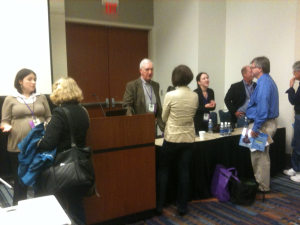By Gabriel Popkin
Going to meetings can be overwhelming and expensive, but if you’re a science reporter or public information officer, you can’t afford to miss them. For science reporters, meetings are a “treasure trove” of research results and opportunities to talk to scientists, said "Tackling the scientific meeting" session moderator Lisa M. P. Munoz, the PIO for the Society for Personality & Social Psychology. For PIOs, they’re an important way to promote members’ research, especially the less flashy results that don’t always get picked up by the press.The PIO’s job at a meeting is largely to help reporters do their jobs. One of the keys to this is a press room where reporters can work and socialize, said Harvey Leifert, a veteran PIO who was with the American Geophysical Union for many years. The press room should have all the equipment reporters need to write and file stories — internet access, electrical outlets, telephones — and, most importantly, food. Food keeps reporters happy and keeps them at the meeting. “I would rather pay money for food at the press room than have fancy electronics,” said Leifert.
PIOs also set up press conferences, which give reporters exceptional access to scientists. Leifert said PIOs should start finding scientists to speak at press conferences as soon as the meeting’s scientific program is set; an ideal press conference will feature three to four speakers organized around a theme. Well-organized, newsworthy press conferences are critical to keep reporters coming back year after year. “The important thing is to try to get your meeting to have some kind of buzz among reporters, and that takes time,” Leifert said.Stephanie Pappas, a reporter for LiveScience, started her presentation with “the two keys to every reporter’s heart: free food, and free wifi.” Pappas also said that PIOs can help reporters take advantage of new media. Some conferences now provide computers specifically for bloggers; at others, PIOs tweet important events. “For a reporter who’s busy covering a couple things a day, it’s really nice to have that social media tip coming from the PIOs,” Pappas said.
Pappas spoke about “getting beyond the press conference.” She said it’s often worthwhile to go to scientists’ actual talks, to hear how they talk to other scientists and not just reporters. And she advised reporters not to discount the poster session, which can be a great place to talk to a lot of scientists in a short amount of time. “I think it’s something that can get overlooked,” she said.
Scientists go to meetings in order to share their work, and appreciate PIOs’ efforts to help them. “We go to a lot of scientific meetings and want to talk,” said Peter Ditto, a social psychologist at the University of California, Irvine. He advised that press briefings occur early in the meeting, so reporters have time to find their stories and go to the relevant talks. All three speakers agreed that reporters should study the program ahead of time to get the most out of a meeting.



